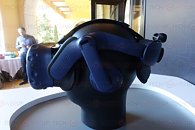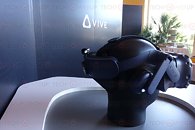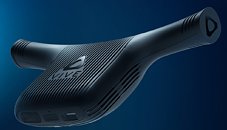Raevenlord
News Editor
- Joined
- Aug 12, 2016
- Messages
- 3,755 (1.15/day)
- Location
- Portugal
| System Name | The Ryzening |
|---|---|
| Processor | AMD Ryzen 9 5900X |
| Motherboard | MSI X570 MAG TOMAHAWK |
| Cooling | Lian Li Galahad 360mm AIO |
| Memory | 32 GB G.Skill Trident Z F4-3733 (4x 8 GB) |
| Video Card(s) | Gigabyte RTX 3070 Ti |
| Storage | Boot: Transcend MTE220S 2TB, Kintson A2000 1TB, Seagate Firewolf Pro 14 TB |
| Display(s) | Acer Nitro VG270UP (1440p 144 Hz IPS) |
| Case | Lian Li O11DX Dynamic White |
| Audio Device(s) | iFi Audio Zen DAC |
| Power Supply | Seasonic Focus+ 750 W |
| Mouse | Cooler Master Masterkeys Lite L |
| Keyboard | Cooler Master Masterkeys Lite L |
| Software | Windows 10 x64 |
HTC took to CES 2018 to announce the next iteration in immersive VR with the VIVE Pro VR headset. The new Vive Pro boasts of much increased per-eye resolution (1440 x 1600 per eye compared to the original VIVE's 1080 x 1200 pixels). Furthermore, the new Vive Pro abandons the 90 Hz LCD technology and makes the move to AMOLED technology for its panels, which keep the 90 Hz refresh rate of the LCD screens with much higher pixel density and image fidelity.




As time passed since the first HTC Vive, so as processing power in our graphics cards increased; however, the new VIVE Pro boasts of 78% higher pixel count when compared to the first-generation VR headsets, which will likely bring most modern GPUs to their knees while attempting to deliver the ideal 90 FPS to the displays. An improved design and ergonomics also make their appearance, as does the integration of headphones, which carry Hi-Rez certification and a built-in amplifier to give your VR worlds that sorely needed extra "oompf".
As an added feature, HTC is also releasing later this years a wireless adapter solution for its VIVE Pro headset, which makes use of WiGig technology to wirelessly transmit information between your computer and the headset over a 60 GHz band - such a frequency is possible due to the short distance between your processing plant (ie, your PC) and your VR headset.


HTC said that the Vive Pro would be available later this quarter as an upgrade kit for existing Vive owners. The new headset will also be available as a full kit, presumably with the integration of Valve's Steam VR Tracking 2.0 base stations, later this year. HTC didn't announce pricing.

View at TechPowerUp Main Site




As time passed since the first HTC Vive, so as processing power in our graphics cards increased; however, the new VIVE Pro boasts of 78% higher pixel count when compared to the first-generation VR headsets, which will likely bring most modern GPUs to their knees while attempting to deliver the ideal 90 FPS to the displays. An improved design and ergonomics also make their appearance, as does the integration of headphones, which carry Hi-Rez certification and a built-in amplifier to give your VR worlds that sorely needed extra "oompf".
As an added feature, HTC is also releasing later this years a wireless adapter solution for its VIVE Pro headset, which makes use of WiGig technology to wirelessly transmit information between your computer and the headset over a 60 GHz band - such a frequency is possible due to the short distance between your processing plant (ie, your PC) and your VR headset.


HTC said that the Vive Pro would be available later this quarter as an upgrade kit for existing Vive owners. The new headset will also be available as a full kit, presumably with the integration of Valve's Steam VR Tracking 2.0 base stations, later this year. HTC didn't announce pricing.

View at TechPowerUp Main Site









